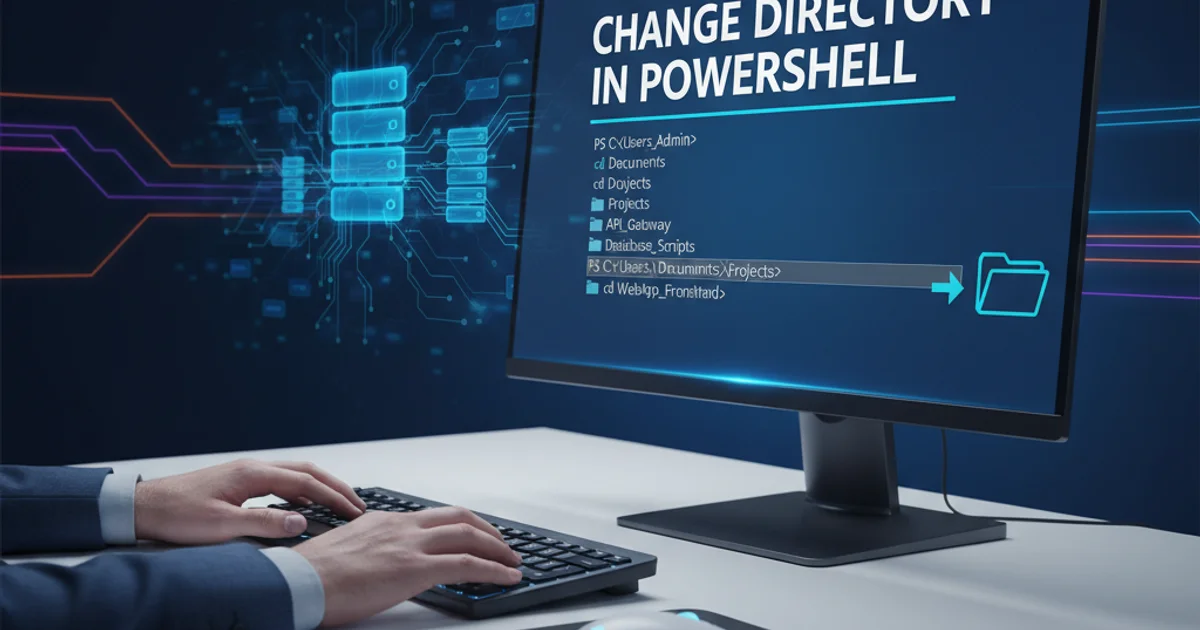Change directory in PowerShell
Categories:
Mastering Directory Navigation in PowerShell

Learn the essential commands and techniques for changing directories in PowerShell, from basic navigation to advanced path manipulation.
Navigating the file system is a fundamental task for any command-line user. In PowerShell, changing directories is intuitive, but understanding its nuances can significantly boost your productivity. This article will guide you through the core commands and best practices for efficient directory management.
The Set-Location Cmdlet: Your Primary Navigation Tool
The Set-Location cmdlet, often aliased as cd (change directory) or chdir, is the primary command for moving between directories in PowerShell. It allows you to specify a path to which you want to navigate. This path can be absolute (starting from the root) or relative (based on your current location).
# Navigate to an absolute path
Set-Location -Path "C:\Program Files\PowerShell"
# Using the 'cd' alias
cd "C:\Users\YourUser\Documents"
# Navigate to a relative path (one level up)
Set-Location ..
# Navigate to a relative path (into a subfolder)
cd MyProject\Src
Basic usage of Set-Location and its cd alias.
Tab to auto-complete directory names, saving time and preventing typos.Understanding Path Types: Absolute vs. Relative
When changing directories, it's crucial to understand the difference between absolute and relative paths. An absolute path specifies the exact location from the root of the drive or file system. A relative path specifies a location in relation to your current working directory.
graph TD
A[Root (C:\)] --> B[Users]
B --> C[YourUser]
C --> D[Documents]
C --> E[Downloads]
D --> F[Projects]
F --> G[MyProject]
subgraph Absolute Path
H["C:\Users\YourUser\Documents\Projects\MyProject"]
end
subgraph Relative Path (from C:\Users\YourUser\Documents)
I["Projects\MyProject"]
end
H --- G
I --- GIllustration of absolute versus relative paths in a file system hierarchy.
Using relative paths is often more convenient for navigating within a project or a specific branch of the file system, as it requires less typing. However, absolute paths are essential when you need to jump to a completely different part of the file system or when scripting to ensure the path is always correct regardless of the script's execution location.
Special Path Notations
PowerShell, like many other shells, uses special notations to represent common directory locations:
# Navigate to the parent directory
cd ..
# Navigate to the current directory (useful for refreshing or re-evaluating context)
cd .
# Navigate to the user's home directory (often C:\Users\YourUser)
cd ~
# Navigate to the previous location in the directory stack
cd -
Special path notations for quick navigation.
~ (tilde) character is a powerful shortcut that always points to your user profile directory, making it easy to access personal files from anywhere.Managing Directory History with Push-Location and Pop-Location
For more advanced navigation, PowerShell maintains a directory stack. This allows you to temporarily move to a different directory and then easily return to your previous location. This is particularly useful when you need to perform a quick task in another directory without losing your current context.
# 1. Start in C:\Users\YourUser\Documents
Set-Location C:\Users\YourUser\Documents
# 2. Push current location onto the stack and move to C:\Windows
Push-Location C:\Windows
# 3. Perform some tasks in C:\Windows...
Get-ChildItem | Select-Object -First 5
# 4. Push current location onto the stack and move to C:\Program Files
Push-Location "C:\Program Files"
# 5. Perform some tasks in C:\Program Files...
Get-ChildItem | Select-Object -First 5
# 6. Pop the last location from the stack (returns to C:\Windows)
Pop-Location
# 7. Pop again (returns to C:\Users\YourUser\Documents)
Pop-Location
Using Push-Location and Pop-Location to manage directory history.
Push-Location and Pop-Location are great for temporary jumps, be mindful of the stack depth in complex scripts to avoid unexpected navigation.Practical Steps for Efficient Directory Changing
Here are some practical steps to make your directory navigation in PowerShell more efficient.
1. Use cd for quick jumps
For everyday navigation, stick to the cd alias. It's concise and familiar to users of other shells.
2. Leverage Tab Completion
Always use Tab to auto-complete directory and file names. This reduces typing errors and speeds up navigation significantly.
3. Master ~ for Home Directory Access
Remember that cd ~ will always take you to your user profile directory, a common starting point for many tasks.
4. Employ Push-Location and Pop-Location for temporary context switches
When you need to briefly visit another directory and then return, use Push-Location to save your current spot and Pop-Location to get back.
5. Check your current location with Get-Location
If you ever get lost, simply type Get-Location (or its alias pwd) to display your current working directory.